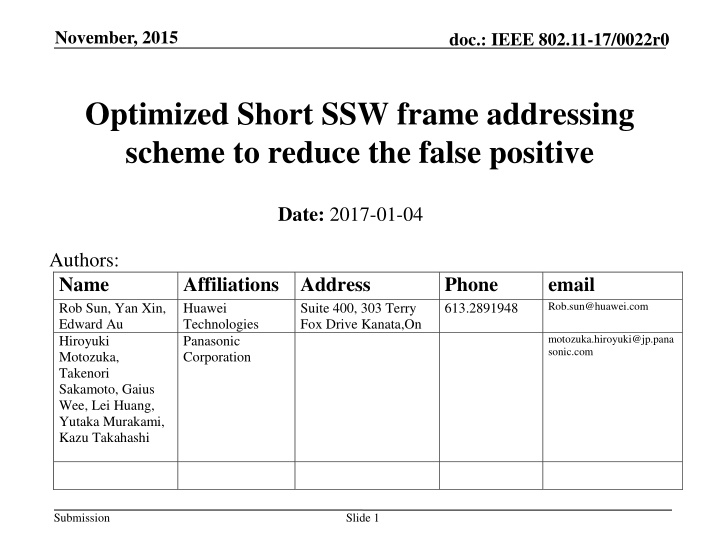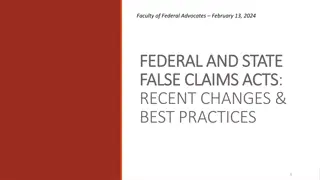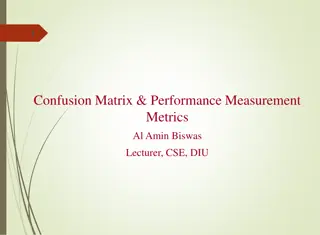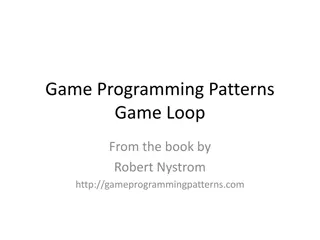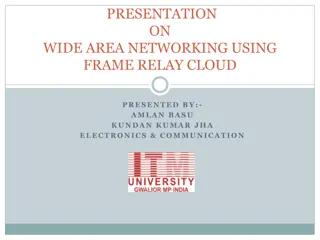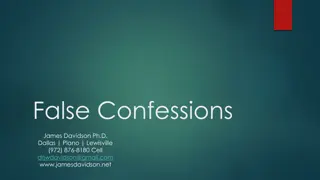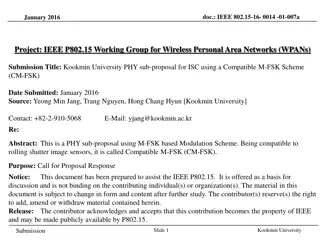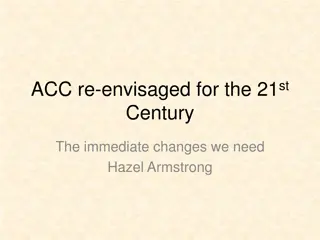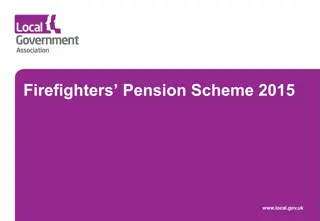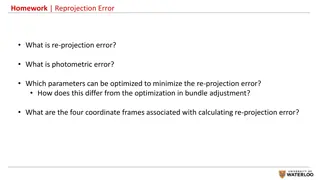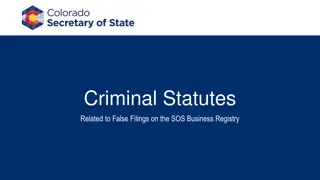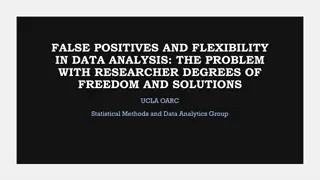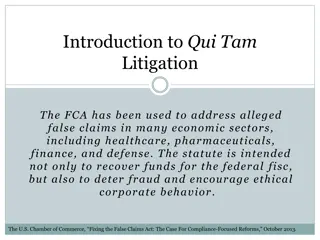Optimized Short SSW Frame Addressing Scheme to Reduce False Positive Rate
Proposal discusses optimizing the addressing scheme in Short SSW frames for IEEE 802.11 to reduce false positives, introducing a 16-bit dual partial AIDs approach and calculating false positive rates based on hashed addresses and AIDs. The method aims to enhance efficiency and decrease collision probabilities in an OBSS environment.
Download Presentation

Please find below an Image/Link to download the presentation.
The content on the website is provided AS IS for your information and personal use only. It may not be sold, licensed, or shared on other websites without obtaining consent from the author.If you encounter any issues during the download, it is possible that the publisher has removed the file from their server.
You are allowed to download the files provided on this website for personal or commercial use, subject to the condition that they are used lawfully. All files are the property of their respective owners.
The content on the website is provided AS IS for your information and personal use only. It may not be sold, licensed, or shared on other websites without obtaining consent from the author.
E N D
Presentation Transcript
November, 2015 doc.: IEEE 802.11-17/0022r0 Optimized Short SSW frame addressing scheme to reduce the false positive Date: 2017-01-04 Authors: Name Rob Sun, Yan Xin, Edward Au Hiroyuki Motozuka, Takenori Sakamoto, Gaius Wee, Lei Huang, Yutaka Murakami, Kazu Takahashi Affiliations Address Huawei Technologies Panasonic Corporation Phone 613.2891948 email Rob.sun@huawei.com Suite 400, 303 Terry Fox Drive Kanata,On motozuka.hiroyuki@jp.pana sonic.com Submission Slide 1
doc.: IEEE 802.11-17/0022r0 Backgrounds In [1], It s proposed to use CRC-16 CCITT to fill the 16 bit addressing field. Packet Type Addressing CDOWN RF Chain ID Short SSW Feedback Direction Reserved FCS Bits: 2 16 11 2 11 1 1 4 The addressing field is still TBD , and we assume it would be as : A(16bits):= CRC16( RA(48bits)||TA(48bits)), whereby the A denotes the Addressing field in the Short SSW frames and RA and TA both denote the addressing field inherent within 11ad SSW frames, CRC16 denotes the CRC 16-CCITT. It s also lack of quantitative analysis of the false positive (probability of collision in the context of OBSS environment). We would like to propose using 16bits dual partial AIDs ( RA- AID(8bit),TA-AID(8bit) to fill up the address field which achieves better false positive probability and efficiency. Addressing RA AID1 TA AID2 Packet Type CDOWN RF Chain ID Short SSW Feedback Direction Reserved FCS Submission Bits: 2 16 11 2 11 1 1 4
doc.: IEEE 802.11-17/0022r0 How to calculate the False Positive Rate The false positive for hashed address calculation within a (P)BSS is based on [3] 2 ) 1 ( /( 2 ) /( 2 ) 2 n n H n H ( , ) 1 1 /( 2 ) p n H e e n H (1) Where n denotes number of STAs per BSS, H equals to 2^m, where m denotes number of bits. Lemma 1: the false positive probability in OBSS (b>=2), the false positive for hashed address for OBSS with equal number of STAs per BSS, is calculated as b H n b n b H b n p 2 ( ) 2 /( ) ) * ) 1 (( ) * (( ) , , ( = ) 1 2 2 2 * / 2 n (2) H Where the b denotes the number of BSS, namely the OBSS. Lemma 2: The false positive for dual AID calculation within OBSS with equal number of STAs is as: H n b H b n p / * ) 1 ( ) , , ( 2 (3) Assuming p<1% is the good false positive rate which is equivalent of PER <10^(-2) Submission
doc.: IEEE 802.11-17/0022r0 Hashed Address vs 16bits dual AIDs b=1 (Single BSS) b=2 (3 OBSS) 10.00% 3.50% 9.00% 3.00% 8.00% 7.00% 2.50% 6.00% 2.00% 5.00% 4.00% 1.50% 3.00% 1.00% 2.00% 0.50% 1.00% 0.00% 0.00% n=2 n=4 n=8 n=16 n=32 n=64 n=2 n=4 n=8 n=16 n=32 n=64 b=5 (5 OBSS) b=8 (8 OBSS) 30.00% 50.00% 25.00% 40.00% 20.00% 30.00% 15.00% 20.00% 10.00% 5.00% 10.00% 0.00% 0.00% n=2 n=4 n=8 n=16 n=32 n=64 n=2 n=4 n=8 n=16 n=32 n=64 Note: - Blue line is the False Positive Probability for Hashed Address Submission - Red line is the False Positive Probability for 16bits dual AIDs
doc.: IEEE 802.11-17/0022r0 RX Decoding Efficiency Decoding Sequence with Hashed Address scheme Decoding Sequence with Dual AID schemes In comparison, the hashed addresses scheme consumes more time in hashing and matching (the box), the time complexity is linearly depending on the size of the List of MAC addresses O(N) in a general case (note) On the contrary, the dual AIDs scheme is straight forward matching with less time and memory consumption. Submission
doc.: IEEE 802.11-17/0022r0 Solution: for the AID=0 problem in OBSS AID =0 problem definition: when DMG PCP/AP assigns the AID to DMG STA, it follows the rule specified in 9.4.1.8 [4] 1-254 are assigned to STAs 0 is assigned to PCP/Aps 255 is assigned to b cast address The 8 MSBs of the AID field to 0 When operating in the OBSS, the false positive probability will be significantly greater when all PCP/APs are assigned with AID=0 In EDMG, PCP/AP may choose to randomly generate the 8 bits EDMG BSS AID applied to the 8 MSBs of the AIDs for both EDMG PCP/APs and EDMG STAs. When the EDMG PCP/AP transmits or receives the short SSW frames, the AID field for EDMG PCP/AP should be filled with the 8 bits of EDMG BSS AID. When the EDMG STA transmits or receives the short SSW frames, the AID field for EDMG STA should be filled with the 8 LSBs of the DMG AID field. The delivery of the EDMG BSS AID: I.e the EDMG BSS AID could be delivered to STA through EDMG capability information elements or EDMG operation elements: Submission 1 1 6 1 1 8 2
doc.: IEEE 802.11-17/0022r0 BSS AID Generation Option I: The BSS AID (8 MSBs of the EDMG AID field) is randomly generated by AP Option II: 8 bit BSS Coloring scheme. Submission
doc.: IEEE 802.11-17/0022r0 Dual AID Addressing with TA check BSS#1 BSS#2 (OBSS) Procedure at the receiver 1 Source(TA) 3 Dest.(RA) 2 4 5 n STAs No collision condition: The same AID values as the RA and TA AID pair is not used in any overlapped BSS(s). Check if the received TA_AID exists in the associated AID list The false positive probability per transmission is: ? ?,?,? = 1 (1 ? ? 1 where ? = 28 ? ? 1)? 1 , Submission 8
doc.: IEEE 802.11-17/0022r0 Analysis False positive probability increases exponentially depending on the number of STAs (n), and the methods based on current proposals may not work for large n (e.g. n>16). We think target false positive probability should be less than 1%. Submission 9
doc.: IEEE 802.11-17/0022r0 Benefit of address scrambling By applying seed to the Addressing, consistent collision can be avoided compared with dual AIDs only. i.e. when SLS is failed, STA can re-try SLS with different seed. Consistent collision rate with two seed (i.e. the rate that both successive two SLSs are failed) should be square of the collision rate per transmission if the scrambling is properly designed. [5] 2016-TECH-Panasonic-0017-00-Short SSW addressing Submission 10
doc.: IEEE 802.11-17/0022r0 Proposed method The addressing is based on Dual AID for the Short SSW addressing fields. In ISS, Short SSW packet includes Short Scrambled BSSID field, whose value is the 10 LSBs of CRC-16-CCITT of the BSSID. The BSSID is scrambled with integer addition scrambling before CRC calculation. BSSID (48 bits) Scrambled BSSID (48 bits) Short Scrambled BSSID (10 bits) Integer addition scrambling CRC-16-CCITT (discard 6 LSBs) When Direction=1 Packet Type 2 RF Chain ID 2 Short SSW Feedback 11 RA AID TA AID CDOWN Direction Reserved FCS 8 8 11 1 1 4 When Direction=0 Reserved SS-BSSID SS-BSSID: Short Scrambled BSSID Bits: 1 10 [5] 2016-TECH-Panasonic-0017-00-Short SSW addressing Submission 11
doc.: IEEE 802.11-17/0022r0 Integer addition scrambling Add a scramble pattern to each 16bit-word of RA and TA i-th word = (i-th word + Pattern) mod 216 The additions should be integer additions instead of XOR Suitable for computation with software/hardware Recommended scramble patterns Pattern = (0x5795 * seed) mod 215 Scramble Pattern (hex) Scramble Pattern (hex) Seed Seed BSSID = 57-89-65-58-2F-17 + 5795 = BSSID = AF-1E-BC-ED-86-AC 0000 3CA8 0 8 + + 5795 143D 1 9 2F2A 6BD2 2 A Pattern 5795 = 5795 = 06BF 4367 3 B 5E54 1AFC 4 C 35E9 7291 5 D 0D7E 4A26 6 E 6513 21BB 7 F Submission 12
doc.: IEEE 802.11-17/0022r0 Receiver procedure (+ collision rate) When Assoc. The false positive probability per transmission is: ? ?,? = 1 (? 1 Construct SS-BSSID table for SI=0to15 ?)? 1, where ? = 210 Performed in advance (optional) The rate is independent from the Addressing scheme and the number of STAs. The rate can be seemed as the upper limit. Receives SSSW packet Combined with some Addressing scheme, additional reduction of collision rate may be achieved. (1) Check if the received SS-BSSID matches to the current SS-BSSID according to the received seed For example, when we use the dual AID with BSS AID scheme[4], the collision rate will be: (2) Check if the received RA AID is own AID ? ?,?,?,? 1 (? 1 ?+1 ?+1 ? ?)? 1, without TA_AID check ?(? 1) ?(? 1))? 1, with TA_AID check ? ? ?,?,?,? 1 (? 1 where ? = 28,? = 210 [4] 2016-TECH-Huawei-0050-01-Short SSW frame addressing scheme with Dual AID (3) Check if the received TA_AID exists in the associated AID list (optional) ? 13 Submission
doc.: IEEE 802.11-17/0022r0 Collision probability analysis Collision probability will be less than 1% with 10bit SS- BSSID for 8 BSSs and any number of STAs. 0.00% 0.10% 0.39% 0.68% Submission 14
doc.: IEEE 802.11-17/0022r0 Conclusion We conducted a collision rate analysis and showed that current solutions[1] suffered from significant performance degradation in OBSS environment. The proposed method which uses Dual AID with TA AID check , and the short scrambled BSSID (SS-BSSID) improves the performance in OBSS, as well as provides means for avoiding consistent collisions. If the TA/RA is the AP itself, the TA/RA AID field should be filled with the 8 bits of the EDMG BSS AID Addressing RA AID1 TA AID2 Packet Type CDOWN RF Chain ID Short SSW Feedback Direction Reserved FCS Bits: 2 16 11 2 11 1 1 4 Submission 15
doc.: IEEE 802.11-17/0022r0 References 1. 11-16-0416-01-00ay-short-ssw-format-for-11ay Submission 16
doc.: IEEE 802.11-17/0022r0 Straw Poll1/Motion Do you agree to define in the SFD, the 16 bits of address field within Short SSW frame to contain RA and TA AID fields. If the TA or RA is the AP itself, the TA or RA AID field should be filled with the 8 bits of the EDMG BSS AID . In case of ISS and Unicast, the Short SSW Feedback field should be replaced by the Short Scrambled BSSID(SS-BSSID) field Submission 17
doc.: IEEE 802.11-17/0022r0 Straw Poll2/Motion Do you agree to add the following to the SFD The BSSID values are scrambled with the following formula before the calculation of SS-BSSID in the Short SSW packet. scrambled i-th word = (i-th word + scramble pattern) mod 216, where each word is the part of the BSSID which is split by 16 bits, and + is integer addition. Submission 18
doc.: IEEE 802.11-17/0022r0 Straw Poll3/Motion Do you agree to add the following to the SFD Scramble patterns for SS-BSSID calculation are defined as follows: Scramble pattern = (0x5795 * seed) mod 128 The seed is the scrambler initialization in the PHY header of the Short SSW packet. Submission 19
